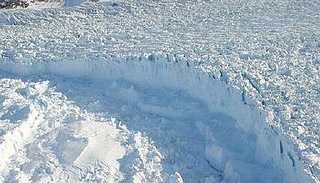 美國科學促進協會17日出刊的《科學》期刊刊載一項新研究指出,由於全球氣溫暖化造成冰河的移動速度加快,過去五年內格陵蘭冰河沒入大西洋的總數成長了一倍。而造成冰河移動加速的原因,似乎地表氣溫上升的緣故。 這是第一次把最近冰河移動速度的改變,納入格陵蘭整體融冰量估算的研究。
美國科學促進協會17日出刊的《科學》期刊刊載一項新研究指出,由於全球氣溫暖化造成冰河的移動速度加快,過去五年內格陵蘭冰河沒入大西洋的總數成長了一倍。而造成冰河移動加速的原因,似乎地表氣溫上升的緣故。 這是第一次把最近冰河移動速度的改變,納入格陵蘭整體融冰量估算的研究。
該論文作者,美國太空總署噴氣推進實驗室瑞格納(Eric Rignot)博士表示:「研究冰河將冰推移至大海的作用,是我們認識冰原與氣候變遷關係的一項重要指標。冰原的建立與融化需要很久的時間,但是冰河可以很快的反映出氣溫的變化。」科學家計算格陵蘭冰河移動速度的依據,主要是利用1996年至2005年的衛星資料。
瑞格納對現今被用來預測格陵蘭融冰量及海平面上升的理論模式表示關切,他認為現今常用的模式是不適用的──因為冰河出口處冰河沒入海洋的速度也會改變,而這項改變並未被這類理論模式計算進去。
如果把冰河移動速度加快的因素列入考慮,論文作者群估算,格陵蘭對使海平面上升的貢獻值,是每年0.5公釐──目前每年海平面上升3公釐。
格陵蘭冰原涵蓋1700萬平方公里,僅比墨西哥國土小一點,最厚處達三公里。如果格陵蘭冰原完全融化,將會使全球海平面上升7公尺。該論文中指出,格陵蘭對海平面上升的貢獻值,有三分之二以上是來自冰河速度加快。
The amount of ice that Greenland's glaciers dump into the Atlantic Ocean has almost doubled in the last five years because glaciers are moving faster as global temperatures warm, finds new research published today in the journal "Science," a publication of the American Association for the Advancement of Science. Rising surface air temperatures appear to be triggering the increases in glacier speed.
This is the first study to incorporate recent changes in glacier velocity into estimates of the overall mass of ice being lost for nearly all of Greenland.
"The behavior of the glaciers that dump ice into the sea is the most important aspect of understanding how an ice sheet will evolve in a changing climate," said Science author Dr. Eric Rignot from NASA's Jet Propulsion Laboratory. "It takes a long time to build and melt an ice sheet, but glaciers can react quickly to temperature changes." The scientists followed the speeds of the Greenland glaciers from space, using satellite data gathered between 1996 and 2005.
Rignot expressed concern that the models now used to predict Greenland's ice loss and contribution to sea level rise are inadequate because they do not account for changes in the speed of outlet glaciers that flow into the sea.
Taking higher glacier speeds into account, the authors calculate that Greenland contributes about 0.5 millimeters per year to global sea level rise which currently stands at three millimeters per year.
The Greenland Ice Sheet is 1.7 million square kilometers, up to three kilometers thick and a little smaller than Mexico. If the Greenland Ice Sheet completely melted, it would raise global sea level by about seven meters .Recent increases in glacier speed on Greenland are responsible for more than two-thirds of Greenland's contribution to sea level rise, the authors say.


